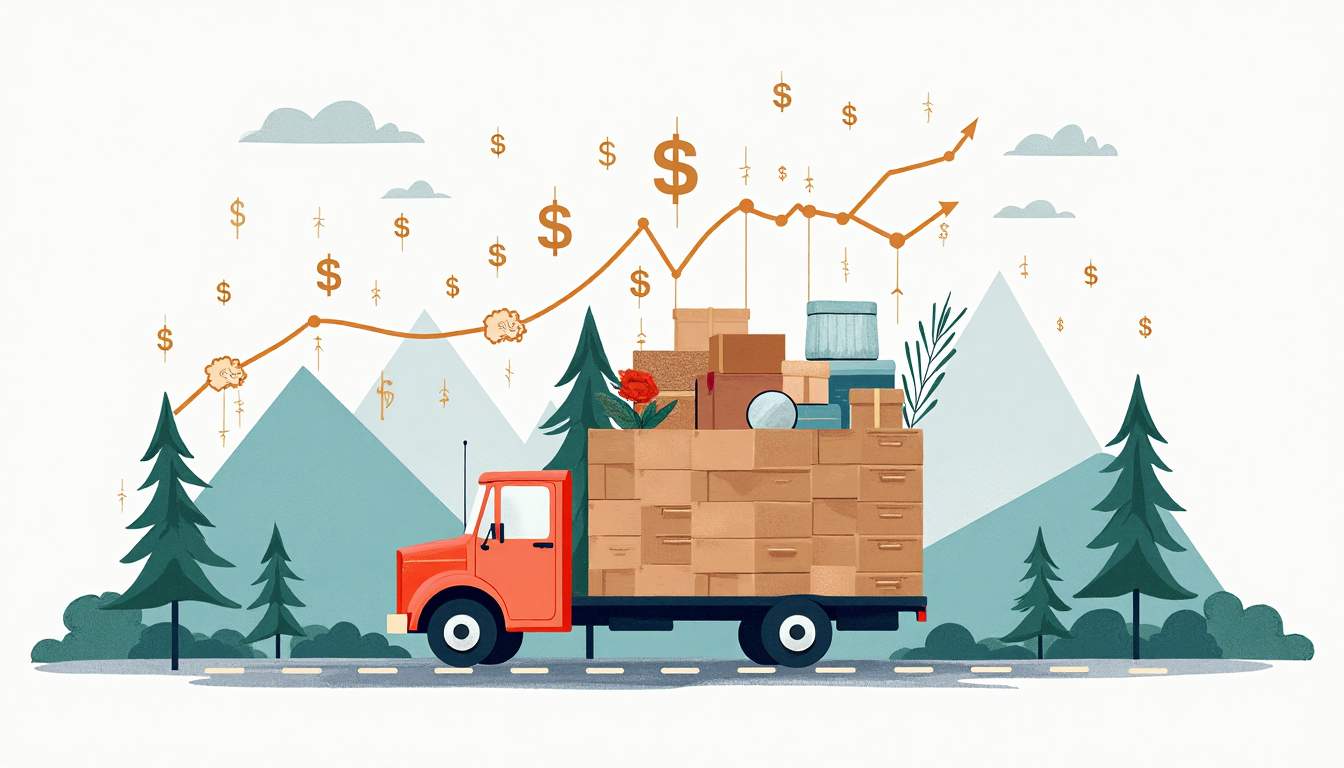Moving across the country or even to a different state is a major life event that requires careful planning, especially when it comes to budgeting. Long-distance moves involve a variety of costs that can quickly add up if not properly understood and managed. In 2025, several factors influence moving expenses, from fuel prices to labor rates and the choice of moving services. This comprehensive guide breaks down all the essential aspects of long-distance moving costs, helping you make informed decisions and avoid surprises.
Understanding What Constitutes a Long-Distance Move
Before diving into costs, it’s important to clarify what qualifies as a long-distance move. Generally, any relocation that exceeds 100 miles or crosses state lines falls under this category. The complexity and expense of moving increase with distance due to factors like transportation logistics, fuel consumption, and additional labor requirements. For instance, when planning a long-distance move, individuals must consider not only the physical distance but also the potential need for temporary storage solutions, which can add to the overall cost and planning process.
Long-distance moves differ significantly from local moves not only in distance but also in the regulations governing moving companies. Interstate moves are regulated by the Federal Motor Carrier Safety Administration (FMCSA), which sets standards for pricing, insurance, and licensing. Understanding these distinctions helps in evaluating quotes and ensuring compliance. Additionally, long-distance moves often require more extensive preparation, such as creating an inventory of belongings and determining the best packing strategies to protect items during transit. This added layer of organization can be crucial in preventing damage and ensuring a smoother transition to the new location.
Moreover, the psychological aspect of a long-distance move should not be overlooked. Relocating to a new state or region can be both exciting and daunting, as it often involves leaving behind familiar surroundings, friends, and routines. This emotional journey can be compounded by the logistics of moving, which may include coordinating travel arrangements for family members or pets. As such, it’s beneficial to take time to research the new area, including schools, healthcare facilities, and community resources, to ease the transition and help everyone adjust to their new environment more comfortably.
Furthermore, the timing of a long-distance move can greatly influence both the cost and the overall experience. Peak moving seasons, typically during the summer months, can lead to higher prices and limited availability of moving services. Conversely, planning a move during the off-peak season may yield better rates and more flexible scheduling options. It’s also wise to consider the weather conditions in both the current and new locations, as adverse weather can complicate the moving process and impact safety. By taking all these factors into account, individuals can better prepare for the challenges of a long-distance move and ensure a more successful relocation experience.
Key Factors Influencing Long-Distance Moving Costs
Distance and Weight of Your Shipment
The two primary factors affecting moving costs are the distance of the move and the total weight of your belongings. Moving companies typically charge based on a combination of these elements. For example, a 1,000-mile move with 5,000 pounds of household goods will cost significantly more than a 500-mile move with 3,000 pounds.
In 2025, the average cost per pound per mile ranges between $0.50 and $0.80, depending on the company and route. This means a move of 1,000 miles with 5,000 pounds could cost anywhere from $2,500 to $4,000 just for transportation.
Seasonal Demand and Timing
Moving costs fluctuate throughout the year. The peak moving season typically runs from May through September, when demand for moving services is highest. During these months, prices can increase by 20-30% due to limited availability of trucks and labor.
Conversely, moving in the off-season (late fall and winter) often results in lower rates and more flexible scheduling. If your timeline allows, planning your move during these months can lead to significant savings.
Additional Services and Special Handling
Beyond basic transportation, many movers offer additional services that impact the total cost. These include packing and unpacking, disassembly and reassembly of furniture, storage solutions, and handling of specialty items like pianos or artwork.
For example, professional packing services can add $300 to $1,000 to your bill depending on the size of your household. Specialty item handling often requires extra insurance and specialized equipment, increasing costs further. It’s important to assess which services you truly need versus those you can manage yourself to control expenses.
Fuel Prices and Transportation Costs
Fuel costs remain a significant variable in moving expenses. In 2025, fluctuating global oil markets have kept diesel prices relatively high, averaging around $4.50 per gallon in the U.S. Since moving trucks consume large amounts of fuel, this directly affects the price charged by moving companies.
Companies may include a fuel surcharge to cover these costs, which can add 5-10% to your overall bill. Asking for a detailed breakdown of fees can help you understand how much of your cost is tied to fuel.
Typical Cost Breakdown for a Long-Distance Move
Transportation Charges
This is the core cost of any long-distance move. It includes the truck rental or use, driver wages, fuel, tolls, and mileage. For moves over 500 miles, transportation can account for 50-60% of the total moving cost.
Labor Fees
Loading and unloading your belongings require skilled labor. Depending on the company, labor can be charged hourly or as a flat fee. In 2025, average labor rates range from $50 to $100 per hour per mover. For a typical 3-bedroom home, expect labor costs between $400 and $1,200.
Packing and Supplies
Whether you hire professionals or do it yourself, packing materials are an added expense. Boxes, tape, bubble wrap, and specialty containers for fragile items can add up to $200-$500 or more. Professional packing services increase this cost but can reduce damage risk.
Insurance and Liability Coverage
Basic liability coverage is usually included, but it often only covers a fraction of your belongings’ value. Full-value protection or third-party insurance can add 1-3% of the declared value of your goods to your moving costs. This is a worthwhile investment to protect against loss or damage.
Storage and Miscellaneous Fees
Sometimes, timing or logistics require temporary storage of your items. Storage fees vary widely but typically cost $50-$200 per month depending on unit size and location. Additional fees may include shuttle services if trucks cannot access your home directly, or fees for bulky or hazardous items.
Average Long-Distance Moving Costs in 2025
Based on industry data and consumer reports, here are some average cost estimates for long-distance moves in 2025:

- Studio or 1-bedroom apartment: $1,200 to $3,000
- 2-3 bedroom home: $3,500 to $7,500
- 4+ bedroom home: $7,000 to $12,000+
These figures include transportation, labor, and basic packing but exclude optional services like full packing or specialty item handling. Keep in mind that moving from high-cost urban areas like New York or San Francisco can push prices higher due to local labor and permit fees.
Tips to Save Money on Your Long-Distance Move
Plan and Book Early
Securing your moving date well in advance can lock in better rates and ensure availability. Last-minute bookings often come with premium charges.
Declutter and Downsize
Reducing the volume and weight of your shipment lowers transportation and labor costs. Donate, sell, or recycle items you no longer need before packing.
Compare Multiple Quotes
Obtain estimates from at least three reputable moving companies. Look beyond price—check reviews, licensing, and insurance coverage to avoid scams and hidden fees.
Consider Hybrid Moving Options
Using portable storage containers or freight shipping for some belongings can reduce costs. You pack your items, and the company transports them, allowing for more control and flexibility.
Handle Packing Yourself
Doing your own packing saves on labor fees. Start early to avoid last-minute stress and use quality packing materials to protect your belongings.
Common Pitfalls and How to Avoid Them
Underestimating Costs
Many people budget only for transportation and overlook additional fees like packing, insurance, and storage. Request a detailed written estimate and clarify what is included.
Choosing the Cheapest Option Without Research
Low bids can be a red flag for subpar service or hidden charges. Verify the mover’s credentials through the FMCSA and read customer reviews.
Ignoring Insurance Coverage
Basic coverage may not be sufficient for valuable items. Always discuss insurance options and consider purchasing additional coverage if needed.
Packing Improperly
Poor packing increases the risk of damage, which can lead to costly claims or loss. Use proper materials and techniques or hire professionals for fragile or high-value items.
Conclusion: Preparing for a Smooth and Cost-Effective Move
Long-distance moving costs in 2025 reflect a combination of distance, weight, timing, and service choices. By understanding the components of your moving bill and planning ahead, you can manage expenses effectively and reduce stress. Whether you’re relocating for a new job, family, or lifestyle change, a well-informed approach to budgeting and selecting moving services ensures your belongings arrive safely and your move stays on track.
Remember to start early, get multiple quotes, and carefully review contracts and insurance options. With the right preparation, your long-distance move can be a positive and exciting transition to your new home.
















